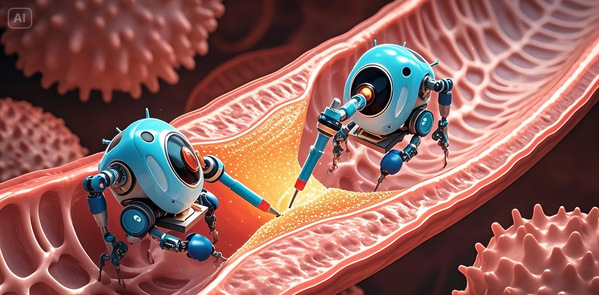banner
Global Launch of the Inaugural Issue of SmartBot, Hosted by Harbin Institute of Technology
Harbin Institute of Technology All-Media Center (Written by Peixiang Liu and Na Li; Photos by Na Li) — Amidst the global wave of innovation in intelligent robotics, the inaugural issue of SmartBot, an international academic journal jointly launched by Harbin Institute of Technology and Wiley Publishing Group, was officially released in March 2025 and made available worldwide. SmartBot is supported by an international editorial board of 49 scholars, including 26 academicians from China and abroad, representing 20 countries and regions. The journal is dedicated to becoming a top-tier international publication in the field of robotics—efficient, high-impact, and high-quality—aiming to establish a world-class platform for academic exchange.
SmartBot is part of China’s Action Plan for Excellence in Science and Technology Journals and was established as a high-level new journal. Backed by the State Key Laboratory of Robotics and System at Harbin Institute of Technology, the journal brings together world-class academic resources in the field of robotics. Professor Bradley Nelson, a member of the Swiss Academy of Engineering Sciences, serves as Editor-in-Chief. Professor Hong Liu, Academician of the Chinese Academy of Engineering and Vice President of Harbin Institute of Technology, chairman the Editorial Board. Professor Longqiu Li of Harbin Institute of Technology serves as Executive Editor-in-Chief. The editorial board includes renowned academicians such as Nanning Zheng, Huayong Yang, Han Ding, Yaonan Wang, Shuxin Wang, and Jianwei Zhang, among others. It also comprises leading scholars in robotics and fellows of international academic organizations such as the Institute of Electrical and Electronics Engineers (IEEE) and the American Society of Mechanical Engineers (ASME), ensuring the journal’s academic authority and global influence.
As a multidisciplinary English-language journal, SmartBot is committed to building a global academic community and promoting the bidirectional transformation between fundamental theoretical research and industrial applications. The journal publishes original research articles, review papers, short communications, commentaries, and perspectives on frontier and interdisciplinary topics in robotics. Areas of interest include, but are not limited to, robotic manufacturing, soft robotics, humanoid robots, micro/nano robots, medical robotics, actuation and control, artificial intelligence, human–robot interaction, mechanism, sensing and detection. All articles are published as open access through the Wiley Online Library platform.
The inaugural issue of SmartBot is themed “Frontier Breakthroughs and Paradigm Innovation in Intelligent Robotics.” It brings together the insights of leading international scholars and features one editorial from the Editor-in-Chief and five authoritative review articles contributed by researchers from China, Switzerland, Germany, and Japan.

The inaugural editorial, featured in the “Editor’s Vision” column, is authored by Editor-in-Chief Professor Bradley Nelson, a member of the Swiss Academy of Engineering Sciences. In this piece, Professor Nelson provides an in-depth analysis of the opportunities and challenges facing the field of intelligent robotics. He identifies 2024 as a pivotal year for the development of robotics technology—particularly in medical applications, where the market is projected to grow at a compound annual growth rate (CAGR) of 16.20%. This accelerating trend underscores the urgent need to establish comprehensive ethical guidelines and an internationally standardized regulatory framework.

Focusing on “Bio-Integrated Microrobots”, one of the featured articles proposes a technological roadmap for the development of bio-integrated microrobots (BIMs). It elaborates on design concepts such as biocompatible materials and cell-material hybrids, compares various fabrication techniques and actuation methods, and analyzes the functional mechanisms of BIMs in medical applications including minimally invasive surgery and targeted drug delivery. The article offers valuable insights to guide the development of intelligent medical robotics.

Centering on the “Performance Theory of Parallel Robots”, another featured article pioneers the construction of a theoretical framework for analyzing motion and force interaction performance in parallel robotic systems. The paper highlights the distinctions between parallel and serial mechanisms, reviews existing research paradigms, and proposes a comprehensive evaluation system encompassing research strategies, assessment methodologies, and performance metrics. This work lays a solid theoretical foundation for the application of parallel mechanisms in precision engineering and heavy-load scenarios.

Focusing on “Robotic-Assisted Endovascular Embolization”, this article proposes a systematic classification method for robotic-assisted endovascular embolization. It evaluates the characteristics of various embolic agents and delivery devices, analyzes key challenges such as material compatibility and operational precision, and forecasts future trends toward increased intelligence and precision. The study offers a valuable reference for technological innovation in interventional radiology.

Focusing on the “Technological Framework of Humanoid Robot,” this article constructs a comprehensive knowledge system for humanoid robot technologies. It analyzes key technological breakthroughs in head and body design from a historical development perspective, evaluates the current state of core technologies such as motion control and environmental perception, and emphasizes the importance of synergistic innovation among technical modules. The study provides strategic guidance for the future development of humanoid robots.

Focusing on “Soft Artificial Muscles,” this article provides a comprehensive review of recent advances in twisted and coiled artificial muscles (TAMs) within the field of soft robotics. It highlights the advantages of TAMs in terms of energy density and load capacity, analyzes various material systems and actuation methods, categorizes TAM structures, and explores their potential applications in manipulation and sensing.
The journal adopts an open access publishing model, and the content of the inaugural issue is freely available at https://onlinelibrary.wiley.com/toc/29981891/2025/1/1. The editorial office warmly invites scholars worldwide to submit their frontier research findings and join efforts to advance innovation in intelligent robotics technology.

